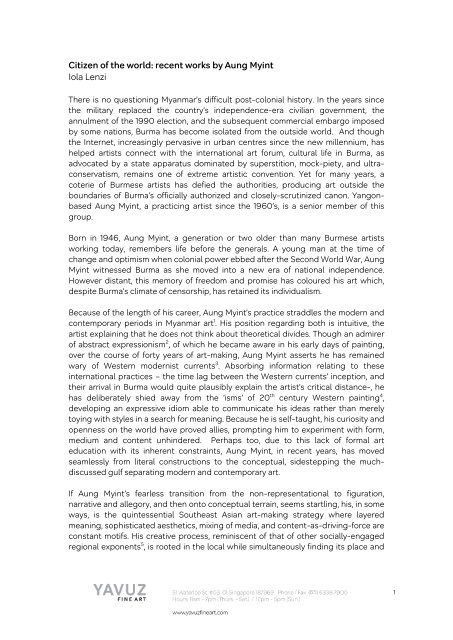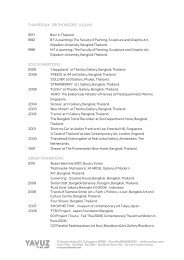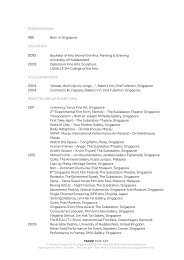Citizen of the world: recent works by Aung Myint Iola ... - Yavuz Fine Art
Citizen of the world: recent works by Aung Myint Iola ... - Yavuz Fine Art
Citizen of the world: recent works by Aung Myint Iola ... - Yavuz Fine Art
You also want an ePaper? Increase the reach of your titles
YUMPU automatically turns print PDFs into web optimized ePapers that Google loves.
<strong>Citizen</strong> <strong>of</strong> <strong>the</strong> <strong>world</strong>: <strong>recent</strong> <strong>works</strong> <strong>by</strong> <strong>Aung</strong> <strong>Myint</strong><br />
<strong>Iola</strong> Lenzi<br />
There is no questioning Myanmar’s difficult post-colonial history. In <strong>the</strong> years since<br />
<strong>the</strong> military replaced <strong>the</strong> country’s independence-era civilian government, <strong>the</strong><br />
annulment <strong>of</strong> <strong>the</strong> 1990 election, and <strong>the</strong> subsequent commercial embargo imposed<br />
<strong>by</strong> some nations, Burma has become isolated from <strong>the</strong> outside <strong>world</strong>. And though<br />
<strong>the</strong> Internet, increasingly pervasive in urban centres since <strong>the</strong> new millennium, has<br />
helped artists connect with <strong>the</strong> international art forum, cultural life in Burma, as<br />
advocated <strong>by</strong> a state apparatus dominated <strong>by</strong> superstition, mock-piety, and ultraconservatism,<br />
remains one <strong>of</strong> extreme artistic convention. Yet for many years, a<br />
coterie <strong>of</strong> Burmese artists has defied <strong>the</strong> authorities, producing art outside <strong>the</strong><br />
boundaries <strong>of</strong> Burma’s <strong>of</strong>ficially authorized and closely-scrutinized canon. Yangonbased<br />
<strong>Aung</strong> <strong>Myint</strong>, a practicing artist since <strong>the</strong> 1960’s, is a senior member <strong>of</strong> this<br />
group.<br />
Born in 1946, <strong>Aung</strong> <strong>Myint</strong>, a generation or two older than many Burmese artists<br />
working today, remembers life before <strong>the</strong> generals. A young man at <strong>the</strong> time <strong>of</strong><br />
change and optimism when colonial power ebbed after <strong>the</strong> Second World War, <strong>Aung</strong><br />
<strong>Myint</strong> witnessed Burma as she moved into a new era <strong>of</strong> national independence.<br />
However distant, this memory <strong>of</strong> freedom and promise has coloured his art which,<br />
despite Burma’s climate <strong>of</strong> censorship, has retained its individualism.<br />
Because <strong>of</strong> <strong>the</strong> length <strong>of</strong> his career, <strong>Aung</strong> <strong>Myint</strong>’s practice straddles <strong>the</strong> modern and<br />
contemporary periods in Myanmar art 1 . His position regarding both is intuitive, <strong>the</strong><br />
artist explaining that he does not think about <strong>the</strong>oretical divides. Though an admirer<br />
<strong>of</strong> abstract expressionism 2 , <strong>of</strong> which he became aware in his early days <strong>of</strong> painting,<br />
over <strong>the</strong> course <strong>of</strong> forty years <strong>of</strong> art-making, <strong>Aung</strong> <strong>Myint</strong> asserts he has remained<br />
wary <strong>of</strong> Western modernist currents 3 . Absorbing information relating to <strong>the</strong>se<br />
international practices – <strong>the</strong> time lag between <strong>the</strong> Western currents’ inception, and<br />
<strong>the</strong>ir arrival in Burma would quite plausibly explain <strong>the</strong> artist’s critical distance-, he<br />
has deliberately shied away from <strong>the</strong> ‘isms’ <strong>of</strong> 20 th century Western painting 4 ,<br />
developing an expressive idiom able to communicate his ideas ra<strong>the</strong>r than merely<br />
toying with styles in a search for meaning. Because he is self-taught, his curiosity and<br />
openness on <strong>the</strong> <strong>world</strong> have proved allies, prompting him to experiment with form,<br />
medium and content unhindered. Perhaps too, due to this lack <strong>of</strong> formal art<br />
education with its inherent constraints, <strong>Aung</strong> <strong>Myint</strong>, in <strong>recent</strong> years, has moved<br />
seamlessly from literal constructions to <strong>the</strong> conceptual, sidestepping <strong>the</strong> muchdiscussed<br />
gulf separating modern and contemporary art.<br />
If <strong>Aung</strong> <strong>Myint</strong>’s fearless transition from <strong>the</strong> non-representational to figuration,<br />
narrative and allegory, and <strong>the</strong>n onto conceptual terrain, seems startling, his, in some<br />
ways, is <strong>the</strong> quintessential Sou<strong>the</strong>ast Asian art-making strategy where layered<br />
meaning, sophisticated aes<strong>the</strong>tics, mixing <strong>of</strong> media, and content-as-driving-force are<br />
constant motifs. His creative process, reminiscent <strong>of</strong> that <strong>of</strong> o<strong>the</strong>r socially-engaged<br />
regional exponents 5 , is rooted in <strong>the</strong> local while simultaneously finding its place and<br />
1
voice in a wider <strong>world</strong> context. Perhaps because he is more interested in meshing a<br />
certain experience <strong>of</strong> being with outward-looking social ideas, <strong>Aung</strong> <strong>Myint</strong>, deploying<br />
an array <strong>of</strong> visual languages, is as comfortable with abstraction as he is<br />
conceptualizing performance and installation 6 . Though in <strong>the</strong> early days <strong>of</strong> his career<br />
paint, canvas, paper and ink were his tools <strong>of</strong> choice, this had as much to do with<br />
what was available as any fixed loyalty to medium. He has never abandoned twodimensional<br />
art, but performance and installation, part <strong>of</strong> his creative repertoire for<br />
many years, complete his expressive palette ra<strong>the</strong>r than clashing with more<br />
conventional modes <strong>of</strong> communication. In this fluid approach to art-making, <strong>Aung</strong><br />
<strong>Myint</strong>’s practice is led <strong>by</strong> concepts ra<strong>the</strong>r than media or formal imperatives.<br />
This leap across <strong>the</strong> divide is not so uncommon for Sou<strong>the</strong>ast Asian artists,<br />
particularly those whose careers have spanned a similar period, art-historically<br />
transitional in <strong>the</strong> West as it has been in Asia. More significantly, modernism,<br />
imported to <strong>the</strong> region ra<strong>the</strong>r than indigenously sown, and thus <strong>of</strong>ten adopted<br />
merely stylistically, divorced from any deeper cultural connection, must be viewed in<br />
<strong>the</strong> larger art-historical context, its long-term relevance, unlike locally-grown<br />
contemporary art, more historical than artistic. Asked about Western modernism’s<br />
introduction to Burma in <strong>the</strong> 20 th century, and later, <strong>the</strong> emergence in Burma <strong>of</strong><br />
contemporary art, <strong>Aung</strong> <strong>Myint</strong> makes clear his dislike <strong>of</strong> labels, his lack <strong>of</strong> interest in<br />
separations and categorisations. On performance, <strong>the</strong> artist is thoughtful. He became<br />
aware <strong>of</strong> it as a form from elsewhere in <strong>the</strong> 1990’s, yet once practicing it himself,<br />
understood it as something familiar 7 , its active, mobile characteristics, and its<br />
intangibility once completed, far from foreign. He does not distinguish it from<br />
painting in terms <strong>of</strong> what it can voice and says it feels innate and comfortable to him,<br />
pulled out into <strong>the</strong> open from a deep place within. This very naturalness vis à vis a<br />
medium <strong>of</strong>ten described –even <strong>by</strong> <strong>the</strong> Burmese artists who espouse it 8 - as <strong>recent</strong><br />
and imported 9 , would instead seem to point to less alien roots. A product <strong>of</strong><br />
contemporary intent though Burmese performance art is, its relationship with older<br />
indigenous cultural expression, unknown in <strong>the</strong> West, can none<strong>the</strong>less not be<br />
ignored. Beyond this keenness on performance, <strong>Aung</strong> <strong>Myint</strong>’s ability to navigate so<br />
competently –and in such an uncontrived manner- between <strong>the</strong> differing modes,<br />
media and goals <strong>of</strong> modern and contemporary suggests he is tackling <strong>the</strong>se strands<br />
<strong>of</strong> his practice with a single methodology connected to his view <strong>of</strong> <strong>the</strong> <strong>world</strong> as a<br />
Burmese.<br />
Not that <strong>Aung</strong> <strong>Myint</strong> adheres to any particular nationalist agenda, especially as exists<br />
in today’s Myanmar. But like several <strong>of</strong> his compatriots, despite a regime that would<br />
tend to inspire disloyalty to home and nation, he has a strong sense <strong>of</strong> cultural<br />
identity tied to country and its strain <strong>of</strong> Therevada Buddhism with its philosophical<br />
leanings 10 . The place <strong>of</strong> community in public life also looms large, particularly<br />
informing his installation and performance.<br />
How <strong>the</strong>n to read <strong>recent</strong> art <strong>by</strong> <strong>Aung</strong> <strong>Myint</strong> exhibited in this latest solo show in<br />
Singapore Though at first glance at opposite ends <strong>of</strong> <strong>the</strong> conceptual and aes<strong>the</strong>tic<br />
spectrum, pieces included in <strong>Citizen</strong> <strong>of</strong> <strong>the</strong> World display <strong>the</strong>ir unity <strong>of</strong> vision.<br />
2
Stylised self-portraits, lines, blotches and scratches scarring <strong>Aung</strong> <strong>Myint</strong>’s buttery oil<br />
impasto, evoke soul and heart as more obvious figuration could not. These canvases’<br />
surface treatment, revealing <strong>the</strong> artist’s passion for <strong>the</strong> sensual side <strong>of</strong> paint, show<br />
<strong>Aung</strong> <strong>Myint</strong> both exposing and masking himself, <strong>the</strong> question <strong>of</strong> his private persona,<br />
blurred with <strong>the</strong> sometimes heavy role he assumes as an artist, coming subtly to <strong>the</strong><br />
fore. These paintings, timeless in genre, perhaps harking back to <strong>the</strong> pre-historic<br />
linear renderings <strong>of</strong> cave paintings 11 , dialogue urbanely with a chair performance/<br />
installation <strong>the</strong> artist also dubs Self Portrait. Conceptualised in <strong>the</strong> 1990s, this work<br />
involves <strong>Aung</strong> <strong>Myint</strong> removing his clo<strong>the</strong>s and draping <strong>the</strong>m on a chair. Simple in<br />
action, its intimacy and familiarity <strong>of</strong> gesture meaningful to all audiences, <strong>the</strong> piece<br />
operates as a contemplation <strong>of</strong> <strong>the</strong> nature <strong>of</strong> being, life, transition, memory and<br />
absence.<br />
Ano<strong>the</strong>r installation, Creatures Besides Our Society, is also a reprise <strong>of</strong> an idea<br />
conceived some time ago, in 2000. Tinged with irony ra<strong>the</strong>r than <strong>the</strong> pathos<br />
colouring <strong>the</strong> previously described chair work, this new parasite piece, its columns <strong>of</strong><br />
bugs on <strong>the</strong> move hinting at <strong>the</strong> dangers <strong>of</strong> conformity as well as <strong>the</strong> paradox <strong>of</strong><br />
small, insidious acts <strong>of</strong> nuisance being responsible for untamable catastrophe,<br />
provides a metaphor for many types <strong>of</strong> contemporary malaises. Initially commenting<br />
environmental issues 12 , <strong>the</strong> work, with its accessible iconographic language, lends<br />
itself to a much broader, socio-political reading.<br />
Two images <strong>of</strong> stupas, one, Black Stupa, a stylized cartoon in <strong>Aung</strong> <strong>Myint</strong>’s poised,<br />
cursive line, <strong>the</strong> second painterly, a solid, white sacred place, White Stupa Doesn’t<br />
Need Gold, speak not <strong>of</strong> <strong>the</strong> exterior trappings <strong>of</strong> faith, but <strong>of</strong> <strong>the</strong> artist’s inner sense<br />
<strong>of</strong> morality and humanity so closely associated with Burmese Buddhism. With this<br />
pair too comes obliquely stated dissent, <strong>Aung</strong> <strong>Myint</strong>’s austere, pure-white religious<br />
emblems deliberately contrasted with today’s ubiquitous stupas <strong>of</strong> ostentation that<br />
are gaudily gilded <strong>by</strong> some Burmese in a bid to burnish <strong>the</strong>ir image as pious and<br />
righteous citizens.<br />
Purely abstract paintings in <strong>Aung</strong> <strong>Myint</strong>’s provocative 13 signature palette <strong>of</strong> black,<br />
white and red 14 , all movement and tense personality, are also represented here.<br />
Though stylistically at odds with <strong>the</strong> installations and World Series paintings, <strong>the</strong>se<br />
pictures, contemporaneous to <strong>the</strong> rest, are coherent within <strong>the</strong> whole, telling <strong>Aung</strong><br />
<strong>Myint</strong>’s tale from a different pictorial angle.<br />
Finally, <strong>the</strong> exhibition assembles various versions <strong>of</strong> <strong>the</strong> artist’s ongoing World Series.<br />
A two-dimensional graphic sequence born in <strong>the</strong> 1990s and featuring images <strong>of</strong><br />
maps <strong>of</strong> <strong>the</strong> five continents, World Series gives form to <strong>Aung</strong> <strong>Myint</strong>’s multi-layered<br />
concerns. This snapshot <strong>of</strong> humanity –here including paintings and a threedimensional<br />
globe work Thorns Cover The World-, constantly developing in pictorial<br />
idiom, takes <strong>the</strong> artist beyond Burma’s physical and psychological borders out into<br />
<strong>the</strong> <strong>world</strong>. There <strong>Aung</strong> <strong>Myint</strong> finds much that is problematic: ecological meltdown,<br />
wars, hate, death and corruption. He paints rivers <strong>of</strong> red blood flowing down his<br />
3
images <strong>of</strong> continents, skulls and crosses pepper his canvases, and torn patches<br />
appear, emblems <strong>of</strong> injury and void. Yet if <strong>the</strong>se <strong>works</strong> are stories <strong>of</strong> doom, <strong>the</strong>y are<br />
also human stories, <strong>the</strong> artist using paint to leap out into <strong>the</strong> fray with zeal, prepared<br />
to tackle global issues as he leaves controlled and controlling Burma behind.<br />
On a less literal level, <strong>the</strong> series also describes Burma’s relationship with <strong>the</strong> <strong>world</strong>: on<br />
one hand <strong>the</strong> mapping a reassuring image <strong>of</strong> inclusiveness even as Burma has spent<br />
<strong>recent</strong> decades as an international pariah; and on <strong>the</strong> o<strong>the</strong>r, <strong>the</strong> sequence<br />
commenting <strong>the</strong> contradiction <strong>of</strong> <strong>the</strong> country’s simultaneous exclusion from <strong>the</strong><br />
<strong>world</strong> community, and her power <strong>of</strong> attraction as a supplier <strong>of</strong> timber, mineral wealth<br />
and o<strong>the</strong>r raw materials. This latter idea was particularly well evoked in a<br />
performance staged in Singapore in May 2010 15 , <strong>the</strong> artist using <strong>the</strong> monotony <strong>of</strong><br />
repeated gesture, deliberate prolongation over several hours, and silence, to<br />
construct a mute, steadily-building-but-never-climaxing-tension as he piled his ricedrawn<br />
outline <strong>of</strong> Burma’s cartography with material symbols <strong>of</strong> economic and massmarket<br />
cultural invasion.<br />
Yet World Series is not didactic, and instead argues for <strong>Aung</strong> <strong>Myint</strong>’s nuanced, multiprismic<br />
vision <strong>of</strong> nation as <strong>the</strong> artist scrutinizes his country from insider and outsider<br />
perspectives –viewers will note that Europe remains at <strong>the</strong> centre <strong>of</strong> <strong>Aung</strong> <strong>Myint</strong>’s<br />
cartography, as it would have been when <strong>the</strong> <strong>world</strong> map first made its way into<br />
Colonial Burma in <strong>the</strong> 19 th century-, pondering her new centrality in a <strong>world</strong> that<br />
ironically, in <strong>recent</strong> years, has been <strong>of</strong>f-limits to most Burmese. An outward looking<br />
meditation on greed, ecological rape, changing global power structures, and art as a<br />
tool <strong>of</strong> popular empowerment, as much as <strong>the</strong> artist’s personal catharsis, <strong>Aung</strong><br />
<strong>Myint</strong>’s World Series <strong>of</strong>fers a powerful but easily understood icon representing <strong>the</strong><br />
complex and changing Burma/outside <strong>world</strong> paradigm.<br />
While parts <strong>of</strong> <strong>Aung</strong> <strong>Myint</strong>’s oeuvre, springing from <strong>the</strong> purely personal, reflect <strong>the</strong><br />
artist’s emotional state, o<strong>the</strong>r bodies are infused with messages and narratives<br />
reaching out past self. <strong>Citizen</strong> <strong>of</strong> <strong>the</strong> <strong>world</strong>: <strong>recent</strong> <strong>works</strong> <strong>by</strong> <strong>Aung</strong> <strong>Myint</strong>, presents<br />
<strong>the</strong>se two facets <strong>of</strong> <strong>the</strong> artist’s creative persona, showing how <strong>Aung</strong> <strong>Myint</strong>’s message<br />
<strong>of</strong> humanism transcends formal and <strong>the</strong>oretical orthodoxies.<br />
October 2010<br />
Copyright © 2010 <strong>Iola</strong> Lenzi<br />
Exhibition Curator <strong>Iola</strong> Lenzi is a Singapore-based critic and researcher specialising<br />
in <strong>the</strong> contemporary visual practices <strong>of</strong> Sou<strong>the</strong>ast Asia.<br />
1 <strong>Aung</strong> Min, Spirit-Myanmar Contemporary <strong>Art</strong>, Beikthano <strong>Art</strong> Gallery, Yangon, 2008, p. 9 for<br />
art critic <strong>Aung</strong> Min’s dating <strong>of</strong> <strong>the</strong> beginning <strong>of</strong> contemporary art in Myanmar to <strong>the</strong> 1990’s.<br />
2 interviews with <strong>the</strong> artist in Singapore, September 2010, reveal <strong>Aung</strong> <strong>Myint</strong>’s interest in <strong>the</strong><br />
work <strong>of</strong> New York school painters Willem de Kooning and Jackson Pollock<br />
3 ibid September 2010 interviews<br />
4 ibid September 2010 interviews<br />
4
5 Sou<strong>the</strong>ast Asian contemporary artists who successfully take local issues to an international<br />
audience include Vasan Sitthiket, Lee Wen, Manit Sriwanichpoom, Arahmaiani, Heri Dono,<br />
Mella Jaarsma, Sutee Kunavichayanont, Dinh Q Le amongst many o<strong>the</strong>rs<br />
6 artist Po Po is widely regarded as Myanmar’s first practitioner <strong>of</strong> performance art<br />
7 ibid September 2010 interviews<br />
8 a finding <strong>of</strong> Nathalie Johnston, researcher <strong>of</strong> Myanmar contemporary art, currently preparing<br />
her MA <strong>the</strong>sis on performance art in Myanmar<br />
9 Taylor, N.,”<strong>Art</strong> in Space: Reflections on <strong>the</strong> Rise <strong>of</strong> Performance <strong>Art</strong> in Vietnam”, Modern and<br />
Contemporary Vietnamese <strong>Art</strong>, Singapore <strong>Art</strong> Museum (May 2008 Symposium papers, in<br />
conjunction with ‘Post Doi-Moi Vietnamese art after 1990’), SAM, 2009, p. 174 for comments<br />
relating to how <strong>the</strong> Vietnamese perceive <strong>the</strong> roots <strong>of</strong> Vietnamese performance art.<br />
10 This is a common attitude amongst Burmese artists. Cf. Lenzi, I., “Myanmar <strong>Art</strong>ists-In<br />
conversation with Nge Lay and <strong>Aung</strong> Ko”, C-<strong>Art</strong>s, Singapore, vol. 15, summer 2010, pp. 60-64<br />
for comments <strong>by</strong> <strong>Aung</strong> Ko and Nge Lay<br />
11 ibid September 2010 interviews when <strong>the</strong> artist discusses his particular interest in ancient<br />
cave paintings and sand-sculpture<br />
12 ibid September 2010 interviews<br />
13 ibid September 2010 interviews, <strong>Aung</strong> <strong>Myint</strong> asserts that <strong>the</strong> Burmese government dislikes<br />
<strong>the</strong> use <strong>of</strong> black and red in painting because <strong>of</strong> <strong>the</strong>ir respective connotations <strong>of</strong> death and<br />
blood.<br />
14 Khin Maung Nyunt, U Sein Myo <strong>Myint</strong>, Ma Thanegi, Myanmar Painting From Worship to Self<br />
Imaging, EPH, Ho Chi Minh City, 2006, p. 16 for a discussion <strong>of</strong> <strong>the</strong> colours used for 12 th century<br />
Bagan wall frescoes, principally black, white and red<br />
15 <strong>Aung</strong> <strong>Myint</strong> presented his performance/installation The Intruders in <strong>the</strong> exhibition ‘PlAy’,<br />
Osage art foundation, Singapore, May 2010<br />
5





